Spatio-Temporal Variability Analysis of Vegetation Dynamics in China from 2000 to 2022 Based on Leaf Area Index: A Multi-Temporal Image Classification Perspective
Abstract
:1. Introduction
2. Materials and Methods
2.1. Satellite Data
2.2. Extraction and Selection of Vegetation Endmembers for China
2.3. Creating China Vegetation Functional Zones (CVFZ) Based on the Selected Endmembers
2.4. Optimization and Validation of the Created CVFZ
2.5. Application at the Regional Scale
2.6. Separation of Annual and Intra-Annual Fluctuations in LAI Time Series
3. Results
3.1. Overview of China Vegetation Functional Zones and CVFZ
3.2. Enhanced Discrimination Compared to Land Cover Datasets
3.3. Performance of CVFZ on Distinguishing LAI Mean Value and LAI Time Series
3.4. Analysis of Annual and Intra-Annual LAI Fluctuations in Different Vegetation Types
4. Discussion
4.1. Potential Advantage of the Use of CVFZ in Vegetation Analysis and Policymaking
4.2. Spatial Variability of Vegetation Dynamics Revealed by CVFZ
4.3. Drivers of Vegetation Dynamics as Jointly Explained with Other Studies
5. Conclusions
- Firstly, CVFZ outperforms MCD12Q1 and CLCD, exhibiting superior performance in distinguishing vegetation with varying functions. Even in smaller zones, CVFZ can also well distinguish vegetation with different functions from the angle of LAI mean or the LAI time series. Although this study does not cover further measured tests, it indicates that the use of the VCA–MLC algorithm provides some taxonomic value in vegetation studies. The resulting CVFZ derivative product offers valuable information for climate and ecological monitoring and management.
- Secondly, the speed of greening of vegetation ranges from 9.02 × 10−4 m2m−2yr−1 in shrubland subregions to 2.34 × 10−2 m2m−2yr−1 in savanna subregions. In relative terms, the average greening speed of forests is moderate, and savannas tend to have the fastest average greening speed. The average greening speed of grasslands and crops with different functions varies widely. In contrast, the average greening speed of shrublands is the smallest.
- Thirdly, as the location of CVFZ shifts to a higher type within the same vegetation, the greening speed generally increases and then decreases, with the slope peaking around types 4–6, and the phenological cycle generally lags but tends to increase; for example, CVFZ-detected grasslands with one or two phenological cycles, broadleaf crops with one or two phenological cycles, and shrublands with one or not-so-obvious phenological cycles.
Author Contributions
Funding
Data Availability Statement
Acknowledgments
Conflicts of Interest
References
- Zeng, J.; Zhang, Q.; Zhang, Y.; Yue, P.; Yang, Z.S.; Wang, S.; Zhang, L.; Li, H.Y. Enhanced Impact of Vegetation on Evapotranspiration in the Northern Drought-Prone Belt of China. Remote Sens. 2023, 15, 221. [Google Scholar] [CrossRef]
- Liu, Y.B.; Xiao, J.F.; Ju, W.M.; Zhu, G.L.; Wu, X.C.; Fan, W.L.; Li, D.Q.; Zhou, Y.L. Satellite-derived LAI products exhibit large discrepancies and can lead to substantial uncertainty in simulated carbon and water fluxes. Remote Sens. Environ. 2018, 206, 174–188. [Google Scholar] [CrossRef]
- Xiao, J.Y.; Xie, B.G.; Zhou, K.C.; Li, J.N.; Xie, J.; Liang, C. Contributions of Climate Change, Vegetation Growth, and Elevated Atmospheric CO2 Concentration to Variation in Water Use Efficiency in Subtropical China. Remote Sens. 2022, 14, 4296. [Google Scholar] [CrossRef]
- Claverie, M.; Matthews, J.L.; Vermote, E.F.; Justice, C.O. A 30+Year AVHRR LAI and FAPAR Climate Data Record: Algorithm Description and Validation. Remote Sens. 2016, 8, 263. [Google Scholar] [CrossRef] [Green Version]
- Bo, Y.; Li, X.K.; Liu, K.; Wang, S.D.; Zhang, H.Y.; Gao, X.J.; Zhang, X.Y. Three Decades of Gross Primary Production (GPP) in China: Variations, Trends, Attributions, and Prediction Inferred from Multiple Datasets and Time Series Modeling. Remote Sens. 2022, 14, 2564. [Google Scholar] [CrossRef]
- Houborg, R.; Soegaard, H.; Boegh, E. Combining vegetation index and model inversion methods for the extraction of key vegetation biophysical parameters using Terra and Aqua MODIS reflectance data. Remote Sens. Environ. 2007, 106, 39–58. [Google Scholar] [CrossRef]
- Yan, H.; Wang, S.Q.; Billesbach, D.; Oechel, W.; Zhang, J.H.; Meyers, T.; Martin, T.A.; Matamala, R.; Baldocchi, D.; Bohrer, G.; et al. Global estimation of evapotranspiration using a leaf area index-based surface energy and water balance model. Remote Sens. Environ. 2012, 124, 581–595. [Google Scholar] [CrossRef] [Green Version]
- Kern, A.; Barcza, Z.; Hollos, R.; Birinyi, E.; Marjanovic, H. Critical Climate Periods Explain a Large Fraction of the Observed Variability in Vegetation State. Remote Sens. 2022, 14, 5621. [Google Scholar] [CrossRef]
- Dai, X.A.; Fan, W.J.; Shan, Y.F.; Gao, Y.; Liu, C.; Nie, R.H.; Zhang, D.H.; Li, W.L.; Zhang, L.F.; Sun, X.J.; et al. LAI-Based Phenological Changes and Climate Sensitivity Analysis in the Three-River Headwaters Region. Remote Sens. 2022, 14, 3748. [Google Scholar] [CrossRef]
- Vremec, M.; Forstner, V.; Herndl, M.; Collenteur, R.; Schaumberger, A.; Birk, S. Sensitivity of evapotranspiration and seepage to elevated atmospheric CO2 from lysimeter experiments in a montane grassland. J. Hydrol. 2023, 617, 128875. [Google Scholar] [CrossRef]
- Cook, B.; Zeng, N.; Yoon, J.H. Will Amazonia Dry Out? Magnitude and Causes of Change from IPCC Climate Model Projections. Earth Interact. 2012, 16, 1–27. [Google Scholar] [CrossRef] [Green Version]
- Lawal, S.; Lennard, C.; Jack, C.; Wolski, P.; Hewitson, B.; Abiodun, B. The observed and model-simulated response of southern African vegetation to drought. Agric. For. Meteorol. 2019, 279, 107698. [Google Scholar] [CrossRef]
- Zhang, W.; Wang, L.C.; Xiang, F.F.; Qin, W.M.; Jiang, W.X. Vegetation dynamics and the relations with climate change at multiple time scales in the Yangtze River and Yellow River Basin, China. Ecol. Indic. 2020, 110, 105892. [Google Scholar] [CrossRef]
- Jiao, W.Z.; Wang, L.X.; McCabe, M.F. Multi-sensor remote sensing for drought characterization: Current status, opportunities and a roadmap for the future. Remote Sens. Environ. 2021, 256, 112313. [Google Scholar] [CrossRef]
- Holm, J.A.; Chambers, J.Q.; Collins, W.D.; Higuchi, N. Forest response to increased disturbance in the central Amazon and comparison to western Amazonian forests. Biogeosciences 2014, 11, 5773–5794. [Google Scholar] [CrossRef] [Green Version]
- Yang, Y.J.; Huang, W.; Xie, T.T.; Li, C.X.; Deng, Y.J.; Chen, J.; Liu, Y.; Ma, S. Elevation Gradients Limit the Antiphase Trend in Vegetation and Its Climate Response in Arid Central Asia. Remote Sens. 2022, 14, 5922. [Google Scholar] [CrossRef]
- Qiu, L.J.; Liu, X.D. Sensitivity analysis of modelled responses of vegetation dynamics on the Tibetan Plateau to doubled CO2 and associated climate change. Theor. Appl. Climatol. 2016, 124, 229–239. [Google Scholar] [CrossRef]
- Piao, S.L.; Ciais, P.; Huang, Y.; Shen, Z.H.; Peng, S.S.; Li, J.S.; Zhou, L.P.; Liu, H.Y.; Ma, Y.C.; Ding, Y.H.; et al. The impacts of climate change on water resources and agriculture in China. Nature 2010, 467, 43–51. [Google Scholar] [CrossRef]
- Zhang, J.; Wu, H.Q.; Zhang, Z.; Zhang, L.L.; Luo, Y.C.; Han, J.C.; Tao, F.L. Asian Rice Calendar Dynamics Detected by Remote Sensing and Their Climate Drivers. Remote Sens. 2022, 14, 4189. [Google Scholar] [CrossRef]
- Luo, H.; Bie, X.J.; Yi, G.H.; Zhou, X.B.; Zhang, T.B.; Li, J.J.; Lai, P.Q. Dominant Impacting Factors on Water-Use Efficiency Variation in Inner Mongolia from 2001 to 2018: Vegetation or Climate? Remote Sens. 2022, 14, 4541. [Google Scholar] [CrossRef]
- Yu, Z.X.; Wang, T.Y.; Wang, P.; Yu, J.J. The Spatiotemporal Response of Vegetation Changes to Precipitation and Soil Moisture in Drylands in the North Temperate Mid-Latitudes. Remote Sens. 2022, 14, 3511. [Google Scholar] [CrossRef]
- Wang, M.M.; Zhao, J.; Wang, S.Q.; Chen, B. Regional Contributions and Climate Attributions to Interannual Variation of Global Net Ecosystems Production by an ECOSYSTEM Processed Model Driven by Remote Sensing Data over the Past 35 Years. Remote Sens. 2022, 14, 3208. [Google Scholar] [CrossRef]
- Forzieri, G.; Alkama, R.; Miralles, D.G.; Cescatti, A. Satellites reveal contrasting responses of regional climate to the widespread greening of Earth. Science 2017, 356, 1140–1144. [Google Scholar] [CrossRef] [PubMed] [Green Version]
- Zeng, Z.Z.; Piao, S.L.; Li, L.Z.X.; Zhou, L.M.; Ciais, P.; Wang, T.; Li, Y.; Lian, X.; Wood, E.F.; Friedlingstein, P.; et al. Climate mitigation from vegetation biophysical feedbacks during the past three decades. Nat. Clim. Chang. 2017, 7, 432–436. [Google Scholar] [CrossRef]
- Zhu, Z.C.; Piao, S.L.; Myneni, R.B.; Huang, M.T.; Zeng, Z.Z.; Canadell, J.G.; Ciais, P.; Sitch, S.; Friedlingstein, P.; Arneth, A.; et al. Greening of the Earth and its drivers. Nat. Clim. Chang. 2016, 6, 791–795. [Google Scholar] [CrossRef]
- Zhang, Y.L.; Song, C.H.; Band, L.E.; Sun, G.; Li, J.X. Reanalysis of global terrestrial vegetation trends from MODIS products: Browning or greening? Remote Sens. Environ. 2017, 191, 145–155. [Google Scholar] [CrossRef] [Green Version]
- Zhou, Y.Q.; Li, Y.M.; Li, W.; Li, F.; Xin, Q.C. Ecological Responses to Climate Change and Human Activities in the Arid and Semi-Arid Regions of Xinjiang in China. Remote Sens. 2022, 14, 3911. [Google Scholar] [CrossRef]
- Caracciolo, D.; Istanbulluoglu, E.; Noto, L.V. An Ecohydrological Cellular Automata Model Investigation of Juniper Tree Encroachment in a Western North American Landscape. Ecosystems 2017, 20, 1104–1123. [Google Scholar] [CrossRef]
- Andela, N.; Liu, Y.Y.; van Dijk, A.; de Jeu, R.A.M.; McVicar, T.R. Global changes in dryland vegetation dynamics (1988–2008) assessed by satellite remote sensing: Comparing a new passive microwave vegetation density record with reflective greenness data. Biogeosciences 2013, 10, 6657–6676. [Google Scholar] [CrossRef] [Green Version]
- Li, X.J.; Qu, Y. Evaluation of Vegetation Responses to Climatic Factors and Global Vegetation Trends using GLASS LAI from 1982 to 2010. Can. J. Remote Sens. 2018, 44, 357–372. [Google Scholar] [CrossRef]
- Curasi, S.R.; Parker, T.C.; Rocha, A.V.; Moody, M.L.; Tang, J.W.; Fetcher, N. Differential responses of ecotypes to climate in a ubiquitous Arctic sedge: Implications for future ecosystem C cycling. New Phytol. 2019, 223, 180–192. [Google Scholar] [CrossRef] [PubMed] [Green Version]
- McManus, K.M.; Morton, D.C.; Masek, J.G.; Wang, D.D.; Sexton, J.O.; Nagol, J.R.; Ropars, P.; Boudreau, S. Satellite-based evidence for shrub and graminoid tundra expansion in northern Quebec from 1986 to 2010. Glob. Chang. Biol. 2012, 18, 2313–2323. [Google Scholar] [CrossRef] [Green Version]
- Law, B.E.; Falge, E.; Gu, L.; Baldocchi, D.D.; Bakwin, P.; Berbigier, P.; Davis, K.; Dolman, A.J.; Falk, M.; Fuentes, J.D.; et al. Environmental controls over carbon dioxide and water vapor exchange of terrestrial vegetation. Agric. For. Meteorol. 2002, 113, 97–120. [Google Scholar] [CrossRef] [Green Version]
- Miller, P.A.; Smith, B. Modelling Tundra Vegetation Response to Recent Arctic Warming. Ambio 2012, 41, 281–291. [Google Scholar] [CrossRef] [Green Version]
- Kim, K.; Wang, M.C.; Ranjitkar, S.; Liu, S.H.; Xu, J.C.; Zomer, R.J. Using leaf area index (LAI) to assess vegetation response to drought in Yunnan province of China. J. Mt. Sci. 2017, 14, 1863–1872. [Google Scholar] [CrossRef]
- Zhang, X.M.; He, G.J.; Zhang, Z.M.; Peng, Y.; Long, T.F. Spectral-spatial multi-feature classification of remote sensing big data based on a random forest classifier for land cover mapping. Clust. Comput.—J. Netw. Softw. Tools Appl. 2017, 20, 2311–2321. [Google Scholar] [CrossRef]
- Hayes, M.M.; Miller, S.N.; Murphy, M.A. High- resolution landcover classification using Random Forest. Remote Sens. Lett. 2014, 5, 112–121. [Google Scholar] [CrossRef]
- Liu, X.; Hu, G.; Chen, Y.; Li, X.; Xu, X.; Li, S.; Pei, F.; Wang, S. High-resolution multi-temporal mapping of global urban land using Landsat images based on the Google Earth Engine Platform. Remote Sens. Environ. 2018, 209, 227–239. [Google Scholar] [CrossRef]
- Ma, L.; Liu, Y.; Zhang, X.L.; Ye, Y.X.; Yin, G.F.; Johnson, B.A. Deep learning in remote sensing applications: A meta-analysis and review. Isprs J. Photogramm. Remote Sens. 2019, 152, 166–177. [Google Scholar] [CrossRef]
- Torabzadeh, H.; Morsdorf, F.; Schaepman, M.E. Fusion of imaging spectroscopy and airborne laser scanning data for characterization of forest ecosystems—A review. Isprs J. Photogramm. Remote Sens. 2014, 97, 25–35. [Google Scholar] [CrossRef]
- Yang, Y.; Xiao, P.; Feng, X.; Li, H. Accuracy assessment of seven global land cover datasets over China. ISPRS J. Photogramm. Remote Sens. 2017, 125, 156–173. [Google Scholar] [CrossRef]
- Su, Y.; Guo, Q.; Xue, B.; Hu, T.; Alvarez, O.; Tao, S.; Fang, J. Spatial distribution of forest aboveground biomass in China: Estimation through combination of spaceborne lidar, optical imagery, and forest inventory data. Remote Sens. Environ. 2016, 173, 187–199. [Google Scholar] [CrossRef] [Green Version]
- Hou, P.; Chen, Y.; Zhai, J.; Hou, J.; Yang, M.; Jin, D.; Zhu, H.; Gao, H.; Wan, H.; Fu, Z. Natural Ecological Background of Terrestrial Vegetation in China: Identification Methods and Spatial Differentiation Characteristics. Sens. Mater. 2021, 33, 4659–4680. [Google Scholar] [CrossRef]
- Seidl, M.; Saifane, M. A green intensity index to better assess the multiple functions of urban vegetation with an application to Paris metropolitan area. Environ. Dev. Sustain. 2021, 23, 15204–15224. [Google Scholar] [CrossRef]
- Houborg, R.; Fisher, J.B.; Skidmore, A.K. Advances in remote sensing of vegetation function and traits. Int. J. Appl. Earth Obs. Geoinf. 2015, 43, 1–6. [Google Scholar] [CrossRef] [Green Version]
- Pu, J.B.; Yan, K.; Zhou, G.H.; Lei, Y.Q.; Zhu, Y.X.; Guo, D.H.; Li, H.L.; Xu, L.L.; Knyazikhin, Y.; Myneni, R.B. Evaluation of the MODIS LAI/FPAR Algorithm Based on 3D-RTM Simulations: A Case Study of Grassland. Remote Sens. 2020, 12, 3391. [Google Scholar] [CrossRef]
- Cui, L.; Wang, L.; Singh, R.P.; Lai, Z.; Jiang, L.; Yao, R. Association analysis between spatiotemporal variation of vegetation greenness and precipitation/temperature in the Yangtze River Basin (China). Environ. Sci. Pollut. Res. 2018, 25, 21867–21878. [Google Scholar] [CrossRef]
- Li, X.L.; Lu, H.; Yu, L.; Yang, K. Comparison of the Spatial Characteristics of Four Remotely Sensed Leaf Area Index Products over China: Direct Validation and Relative Uncertainties. Remote Sens. 2018, 10, 148. [Google Scholar] [CrossRef] [Green Version]
- Peng, Z.; Li, Y.; Yu, W.; Xing, Y.; Feng, A.; Du, S. Research on the Applicability of Remote Sensing Precipitation Products in Different Climatic Regions of China. J. Geo-Inf. Sci. 2021, 23, 1296–1311. [Google Scholar]
- Wei, F.L.; Wang, S.; Fu, B.J.; Pan, N.Q.; Feng, X.M.; Zhao, W.W.; Wang, C. Vegetation dynamic trends and the main drivers detected using the ensemble empirical mode decomposition method in East Africa. Land Degrad. Dev. 2018, 29, 2542–2553. [Google Scholar] [CrossRef]
- Chen, Z.; Chen, Y.; Bai, L.; Xu, J. Multiscale evolution of surface air temperature in the arid region of Northwest China and its linkages to ocean oscillations. Theor. Appl. Climatol. 2017, 128, 945–958. [Google Scholar] [CrossRef]
- Pan, N.; Feng, X.; Fu, B.; Wang, S.; Ji, F.; Pan, S. Increasing global vegetation browning hidden in overall vegetation greening: Insights from time-varying trends. Remote Sens. Environ. 2018, 214, 59–72. [Google Scholar] [CrossRef]
- Hawinkel, P.; Swinnen, E.; Lhermitte, S.; Verbist, B.; Van Orshoven, J.; Muys, B. A time series processing tool to extract climate-driven interannual vegetation dynamics using Ensemble Empirical Mode Decomposition (EEMD). Remote Sens. Environ. 2015, 169, 375–389. [Google Scholar] [CrossRef] [Green Version]
- Petrakis, R.; Wu, Z.T.; McVay, J.; Middleton, B.; Dye, D.; Vogel, J. Vegetative response to water availability on the San Carlos Apache Reservation. For. Ecol. Manag. 2016, 378, 14–23. [Google Scholar] [CrossRef] [Green Version]
- Xu, G.; Zhang, H.; Chen, B.; Zhang, H.; Innes, J.L.; Wang, G.; Yan, J.; Zheng, Y.; Zhu, Z.; Myneni, R.B. Changes in Vegetation Growth Dynamics and Relations with Climate over China’s Landmass from 1982 to 2011. Remote Sens. 2014, 6, 3263–3283. [Google Scholar] [CrossRef] [Green Version]
- Yan, K.; Park, T.; Yan, G.J.; Chen, C.; Yang, B.; Liu, Z.; Nemani, R.R.; Knyazikhin, Y.; Myneni, R.B. Evaluation of MODIS LAI/FPAR Product Collection 6. Part 1: Consistency and Improvements. Remote Sens. 2016, 8, 359. [Google Scholar] [CrossRef] [Green Version]
- Yan, K.; Park, T.; Yan, G.J.; Liu, Z.; Yang, B.; Chen, C.; Nemani, R.R.; Knyazikhin, Y.; Myneni, R.B. Evaluation of MODIS LAI/FPAR Product Collection 6. Part 2: Validation and Intercomparison. Remote Sens. 2016, 8, 460. [Google Scholar] [CrossRef] [Green Version]
- Fu, L.; Qu, Y.; Wang, J. Bias analysis and validation method of the MODIS LAI product. J. Remote Sens. 2017, 21, 206–217. [Google Scholar]
- Zou, D.; Yan, K.; Pu, J.; Gao, S.; Li, W.; Mu, X.; Knyazikhin, Y.; Myneni, R.B. Revisit the Performance of MODIS and VIIRS Leaf Area Index Products from the Perspective of Time-Series Stability. IEEE J. Sel. Top. Appl. Earth Obs. Remote Sens. 2022, 15, 8958–8973. [Google Scholar] [CrossRef]
- Fang, H.L.; Wei, S.S.; Jiang, C.Y.; Scipal, K. Theoretical uncertainty analysis of global MODIS, CYCLOPES, and GLOBCARBON LAI products using a triple collocation method. Remote Sens. Environ. 2012, 124, 610–621. [Google Scholar] [CrossRef]
- Mayr, M.J.; Samimi, C. Comparing the Dry Season In-Situ Leaf Area Index (LAI) Derived from High-Resolution RapidEye Imagery with MODIS LAI in a Namibian Savanna. Remote Sens. 2015, 7, 4834–4857. [Google Scholar] [CrossRef] [Green Version]
- Liu, D.; Yu, C.; Zhao, F. Response of the water use efficiency of natural vegetation to drought in Northeast China. J. Geogr. Sci. 2018, 28, 611–628. [Google Scholar] [CrossRef] [Green Version]
- Zhang, Y.; Yuan, J.; Zhang, S. Spatial-temporal change of leaf area index (LAI) of vegetations in Hebei Province from 2002 to 2011. J. Nanjing For. Univ. Nat. Sci. Ed. 2015, 39, 86–92. [Google Scholar]
- Yang, J.; Huang, X. The 30 m annual land cover dataset and its dynamics in China from 1990 to 2019. Earth Syst. Sci. Data 2021, 13, 3907–3925. [Google Scholar] [CrossRef]
- Du, B.; Wei, Q.; Liu, R. An Improved Quantum-Behaved Particle Swarm Optimization for Endmember Extraction. IEEE Trans. Geosci. Remote Sens. 2019, 57, 6003–6017. [Google Scholar] [CrossRef]
- Zhang, B.; Sun, X.; Gao, L.; Yang, L. Endmember Extraction of Hyperspectral Remote Sensing Images Based on the Ant Colony Optimization (ACO) Algorithm. IEEE Trans. Geosci. Remote Sens. 2011, 49, 2635–2646. [Google Scholar] [CrossRef]
- Nascimento, J.M.P.; Bioucas-Dias, J.M.; Rodriguez Alves, J.M.; Silva, V.; Plaza, A. Parallel Hyperspectral Unmixing on GPUs. IEEE Geosci. Remote Sens. Lett. 2014, 11, 666–670. [Google Scholar] [CrossRef]
- Yan, K.; Gao, S.; Chi, H.; Qi, J.; Song, W.; Tong, Y.; Mu, X.; Yan, G. Evaluation of the Vegetation-Index-Based Dimidiate Pixel Model for Fractional Vegetation Cover Estimation. IEEE Trans. Geosci. Remote Sens. 2022, 60, 4400514. [Google Scholar] [CrossRef]
- Nascimento, J.M.P.; Dias, J.M.B. Vertex component analysis: A fast algorithm to unmix hyperspectral data. IEEE Trans. Geosci. Remote Sens. 2005, 43, 898–910. [Google Scholar] [CrossRef] [Green Version]
- Mettas, C.; Agapiou, A.; Themistocleous, K.; Neocleous, K.; Hadjimitsis, D.G. Detection of asphalt pavement cracks using remote sensing techniques. In Proceedings of the Conference on Remote Sensing Technologies and Applications for Urban Environments, Edinburgh, Scotland, 26–27 September 2016. [Google Scholar]
- Sun, Y.; Zhang, X.; Shuai, T.; Shang, K.; Feng, S.n. Radiometric normalization of hyperspectral satellite images with spectral angle distance and Euclidean distance. J. Remote Sens. 2015, 19, 618–626. [Google Scholar]
- Kogo, B.K.; Kumar, L.; Koech, R. Analysis of spatio-temporal dynamics of land use and cover changes in Western Kenya. Geocarto Int. 2021, 36, 376–391. [Google Scholar] [CrossRef]
- Xu, F.; Zhang, W.; Cheng, Y.; Chu, W.; Assoc Comp, M. Metric Learning with Equidistant and Equidistributed Triplet-based Loss for Product Image Search. In Proceedings of the 29th Web Conference (WWW), Taipei, Taiwan, 20–24 April 2020; pp. 57–65. [Google Scholar]
- Wu, C.M.; Guo, X.K. A Novel Single Fuzzifier Interval Type-2 Fuzzy C-Means Clustering With Local Information for Land-Cover Segmentation. IEEE J. Sel. Top. Appl. Earth Obs. Remote Sens. 2021, 14, 5903–5917. [Google Scholar] [CrossRef]
- Cristina, S.; Cordeiro, C.; Lavender, S.; Goela, P.C.; Icely, J.; Newton, A. MERIS Phytoplankton Time Series Products from the SW Iberian Peninsula (Sagres) Using Seasonal-Trend Decomposition Based on Loess. Remote Sens. 2016, 8, 449. [Google Scholar] [CrossRef] [Green Version]
- Wang, G.G.; Li, X.M.; Zhao, K.X.; Li, Y.K.; Sun, X.W. Quantifying the Spatio-Temporal Variations and Impacts of Factors on Vegetation Water Use Efficiency Using STL Decomposition and Geodetector Method. Remote Sens. 2022, 14, 5926. [Google Scholar] [CrossRef]
- Yan, K.; Pu, J.B.; Park, T.; Xu, B.D.; Zeng, Y.L.; Yan, G.J.; Weiss, M.; Knyazikhin, Y.; Myneni, R.B. Performance stability of the MODIS and VIIRS LAI algorithms inferred from analysis of long time series of products. Remote Sens. Environ. 2021, 260, 112438. [Google Scholar] [CrossRef]
- Jiang, B.; Liang, S.L.; Wang, J.D.; Xiao, Z.Q. Modeling MODIS LAI time series using three statistical methods. Remote Sens. Environ. 2010, 114, 1432–1444. [Google Scholar] [CrossRef]
- Sang, Y.; Liu, G.; Jiang, C.; Ren, S.; Zhu, Z. Uncertainty Assessment of the Trend of China’s Leaf Area Index in the Past 30 Years. Remote Sens. Technol. Appl. 2020, 35, 1028–1036. [Google Scholar]
- Dong, S.; Wang, P.; Abbas, K. A survey on deep learning and its applications. Comput. Sci. Rev. 2021, 40, 100379. [Google Scholar] [CrossRef]
- Reichstein, M.; Camps-Valls, G.; Stevens, B.; Jung, M.; Denzler, J.; Carvalhais, N.; Prabhat. Deep learning and process understanding for data-driven Earth system science. Nature 2019, 566, 195–204. [Google Scholar] [CrossRef]
- Mao, K.; Gao, F.; Zhang, S.; Liu, C. An Information Spatial-Temporal Extension Algorithm for Shipborne Predictions Based on Deep Neural Networks with Remote Sensing Observations—Part I: Ocean Temperature. Remote Sens. 2022, 14, 1791. [Google Scholar] [CrossRef]
- Wong, C.P.; Jiang, B.; Kinzig, A.P.; Lee, K.N.; Ouyang, Z.Y. Linking ecosystem characteristics to final ecosystem services for public policy. Ecol. Lett. 2015, 18, 108–118. [Google Scholar] [CrossRef] [PubMed] [Green Version]
- He, Z.C.; Xiao, L.S.; Guo, Q.H.; Liu, Y.; Mao, Q.Z.; Kareiva, P. Evidence of causality between economic growth and vegetation dynamics and implications for sustainability policy in Chinese cities. J. Clean. Prod. 2020, 251, 119550. [Google Scholar] [CrossRef]
- Brancalion, P.H.S.; Garcia, L.C.; Loyola, R.; Rodrigues, R.R.; Pillar, V.D.; Lewinsohn, T.M. A critical analysis of the Native Vegetation Protection Law of Brazil (2012): Updates and ongoing initiatives. Nat. Conserv. 2016, 14, 1–15. [Google Scholar] [CrossRef] [Green Version]
- Martinez, A.D.; Labib, S.M. Demystifying normalized difference vegetation index (NDVI) for greenness exposure assessments and policy interventions in urban greening. Environ. Res. 2023, 220, 115155. [Google Scholar] [CrossRef]
- Tong, Y.; Zhou, H.F.; Jiang, L. Exploring the transition effects of foreign direct investment on the eco-efficiency of Chinese cities: Based on multi-source data and panel smooth transition regression models. Ecol. Indic. 2021, 121, 107073. [Google Scholar] [CrossRef]
- Bao, G.; Qin, Z.; Bao, Y.; Zhou, Y.; Li, W.; Sanjjav, A. NDVI-Based Long-Term Vegetation Dynamics and Its Response to Climatic Change in the Mongolian Plateau. Remote Sens. 2014, 6, 8337–8358. [Google Scholar] [CrossRef] [Green Version]
- Tang, L.; Chen, X.; Cai, X.; Li, J. Disentangling the roles of land-use-related drivers on vegetation greenness across China. Environ. Res. Lett. 2021, 16, 124033. [Google Scholar] [CrossRef]
- Chen, J.; Shao, Z.; Huang, X.; Zhuang, Q.; Dang, C.; Cai, B.; Zheng, X.; Ding, Q. Assessing the impact of drought-land cover change on global vegetation greenness and productivity. Sci. Total Environ. 2022, 852, 158499. [Google Scholar] [CrossRef]
- Zhang, W.Q.; Jin, H.A.; Shao, H.Y.; Li, A.N.; Li, S.Z.; Fan, W.J. Temporal and Spatial Variations in the Leaf Area Index and Its Response to Topography in the Three-River Source Region, China from 2000 to 2017. ISPRS Int. J. Geo-Inf. 2021, 10, 33. [Google Scholar] [CrossRef]
- Piao, S.; Yin, G.; Tan, J.; Cheng, L.; Huang, M.; Li, Y.; Liu, R.; Mao, J.; Myneni, R.B.; Peng, S.; et al. Detection and attribution of vegetation greening trend in China over the last 30 years. Glob. Chang. Biol. 2015, 21, 1601–1609. [Google Scholar] [CrossRef]
- Munier, S.; Carrer, D.; Planque, C.; Camacho, F.; Albergel, C.; Calvet, J.-C. Satellite Leaf Area Index: Global Scale Analysis of the Tendencies per Vegetation Type over the Last 17 Years. Remote Sens. 2018, 10, 424. [Google Scholar] [CrossRef] [Green Version]
- Maimaitiyiming, M.; Ghulam, A.; Tiyip, T.; Pla, F.; Latorre-Carmona, P.; Halik, U.; Sawut, M.; Caetano, M. Effects of green space spatial pattern on land surface temperature: Implications for sustainable urban planning and climate change adaptation. Isprs J. Photogramm. Remote Sens. 2014, 89, 59–66. [Google Scholar] [CrossRef] [Green Version]
- Tang, H.; Li, Z.; Zhu, Z.; Chen, B.; Zhang, B.; Xin, X. Variability and Climate Change Trend in Vegetation Phenology of Recent Decades in the Greater Khingan Mountain Area, Northeastern China. Remote Sens. 2015, 7, 11914–11932. [Google Scholar] [CrossRef] [Green Version]
- Li, L.; Zhang, Y.; Liu, L.; Wu, J.; Wang, Z.; Li, S.; Zhang, H.; Zu, J.; Ding, M.; Paudel, B. Spatiotemporal Patterns of Vegetation Greenness Change and Associated Climatic and Anthropogenic Drivers on the Tibetan Plateau during 2000–2015. Remote Sens. 2018, 10, 1525. [Google Scholar] [CrossRef] [Green Version]
- Huang, K.; Zhang, Y.; Zhu, J.; Liu, Y.; Zu, J.; Zhang, J. The Influences of Climate Change and Human Activities on Vegetation Dynamics in the Qinghai-Tibet Plateau. Remote Sens. 2016, 8, 876. [Google Scholar] [CrossRef] [Green Version]
- Song, Y.; Jin, L.; Wang, H. Vegetation Changes along the Qinghai-Tibet Plateau Engineering Corridor Since 2000 Induced by Climate Change and Human Activities. Remote Sens. 2018, 10, 95. [Google Scholar] [CrossRef] [Green Version]
- Jiang, M.; Tian, S.; Zheng, Z.; Zhan, Q.; He, Y. Human Activity Influences on Vegetation Cover Changes in Beijing, China, from 2000 to 2015. Remote Sens. 2017, 9, 271. [Google Scholar] [CrossRef] [Green Version]
- Huang, H.; Chen, Y.; Clinton, N.; Wang, J.; Wang, X.; Liu, C.; Gong, P.; Yang, J.; Bai, Y.; Zheng, Y.; et al. Mapping major land cover dynamics in Beijing using all Landsat images in Google Earth Engine. Remote Sens. Environ. 2017, 202, 166–176. [Google Scholar] [CrossRef]
- Tong, X.; Wang, K.; Yue, Y.; Brandt, M.; Liu, B.; Zhang, C.; Liao, C.; Fensholt, R. Quantifying the effectiveness of ecological restoration projects on long-term vegetation dynamics in the karst regions of Southwest China. Int. J. Appl. Earth Obs. Geoinf. 2017, 54, 105–113. [Google Scholar] [CrossRef] [Green Version]
- Liu, Y.; Lei, H. Responses of Natural Vegetation Dynamics to Climate Drivers in China from 1982 to 2011. Remote Sens. 2015, 7, 10243–10268. [Google Scholar] [CrossRef] [Green Version]
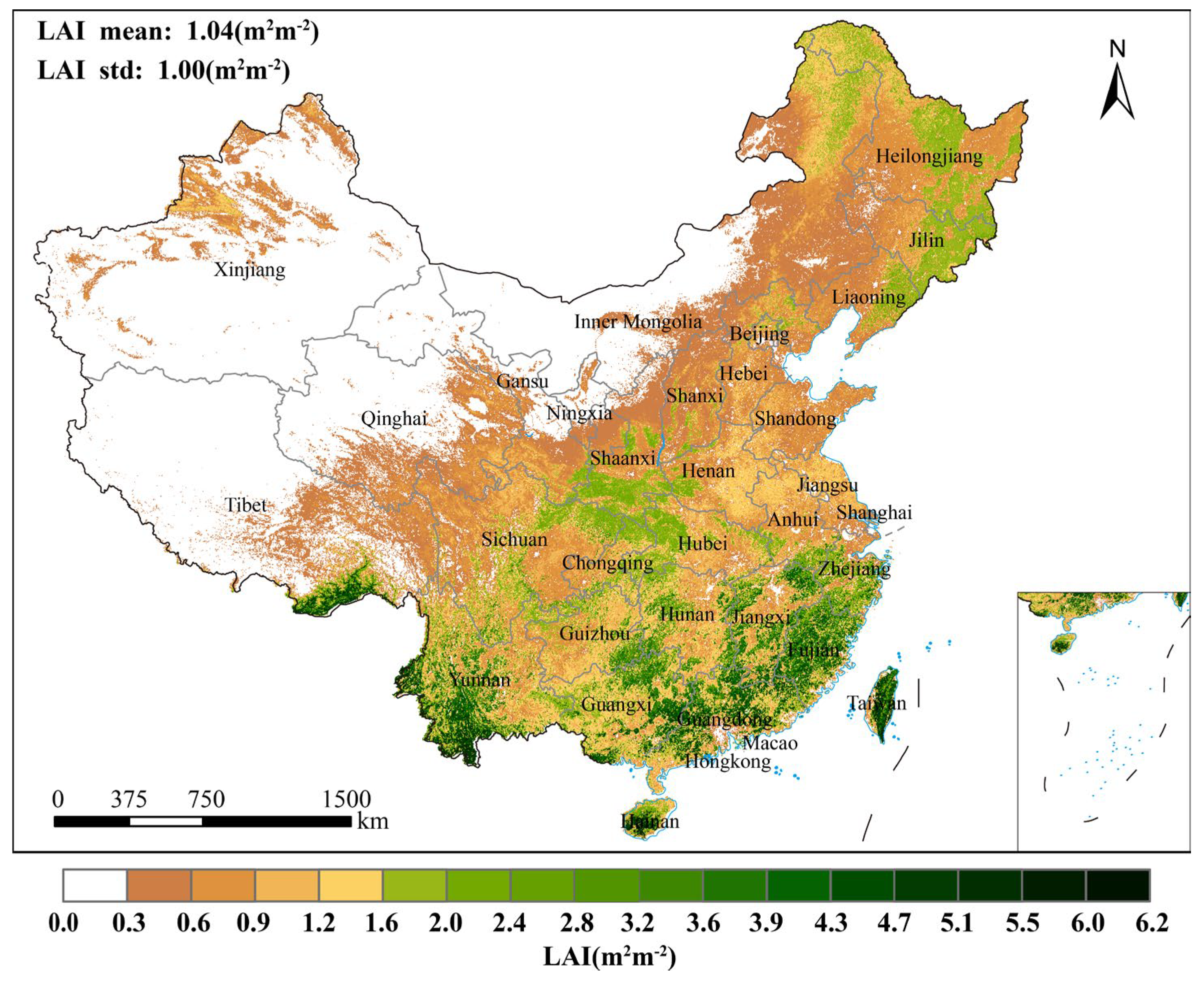

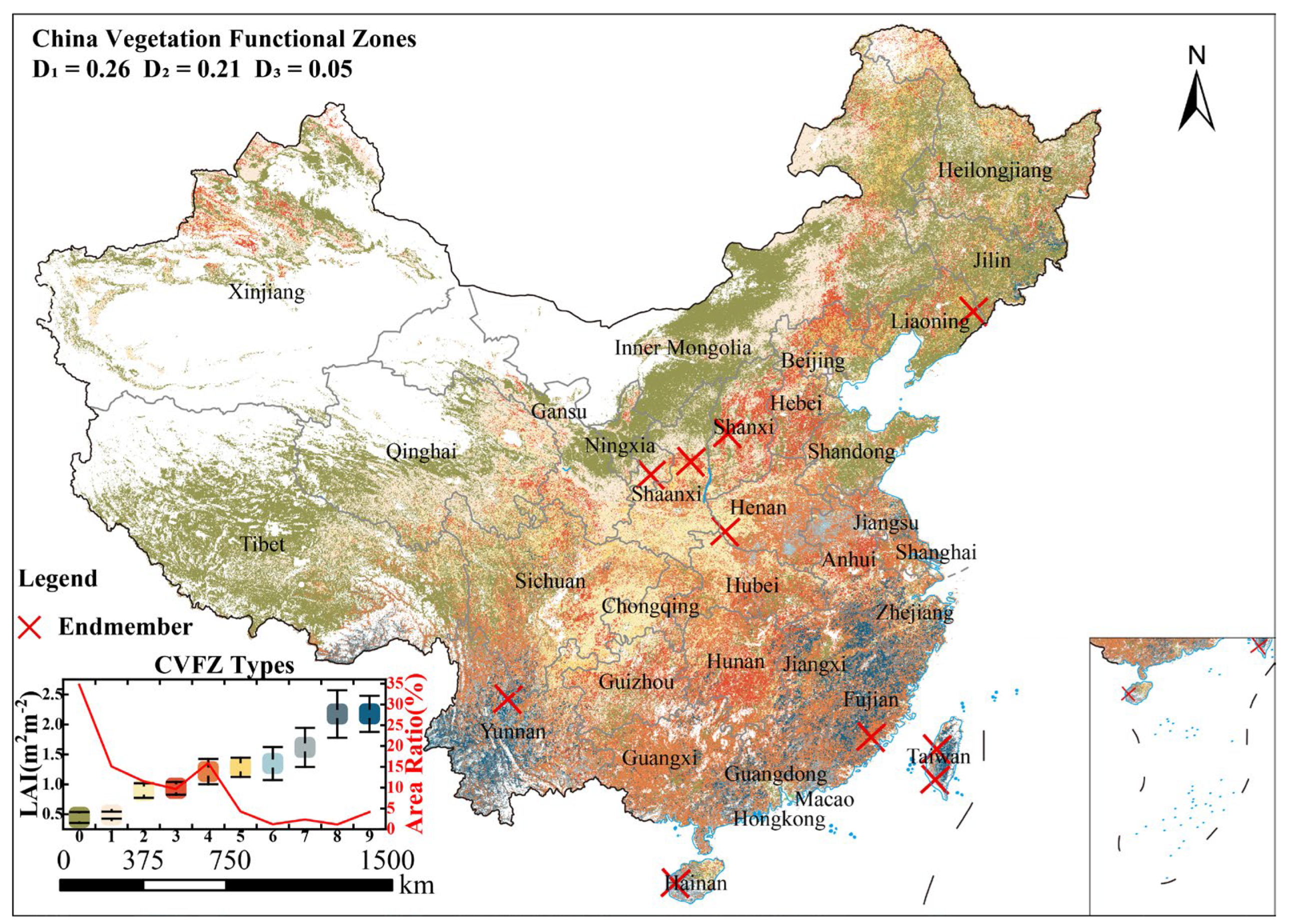
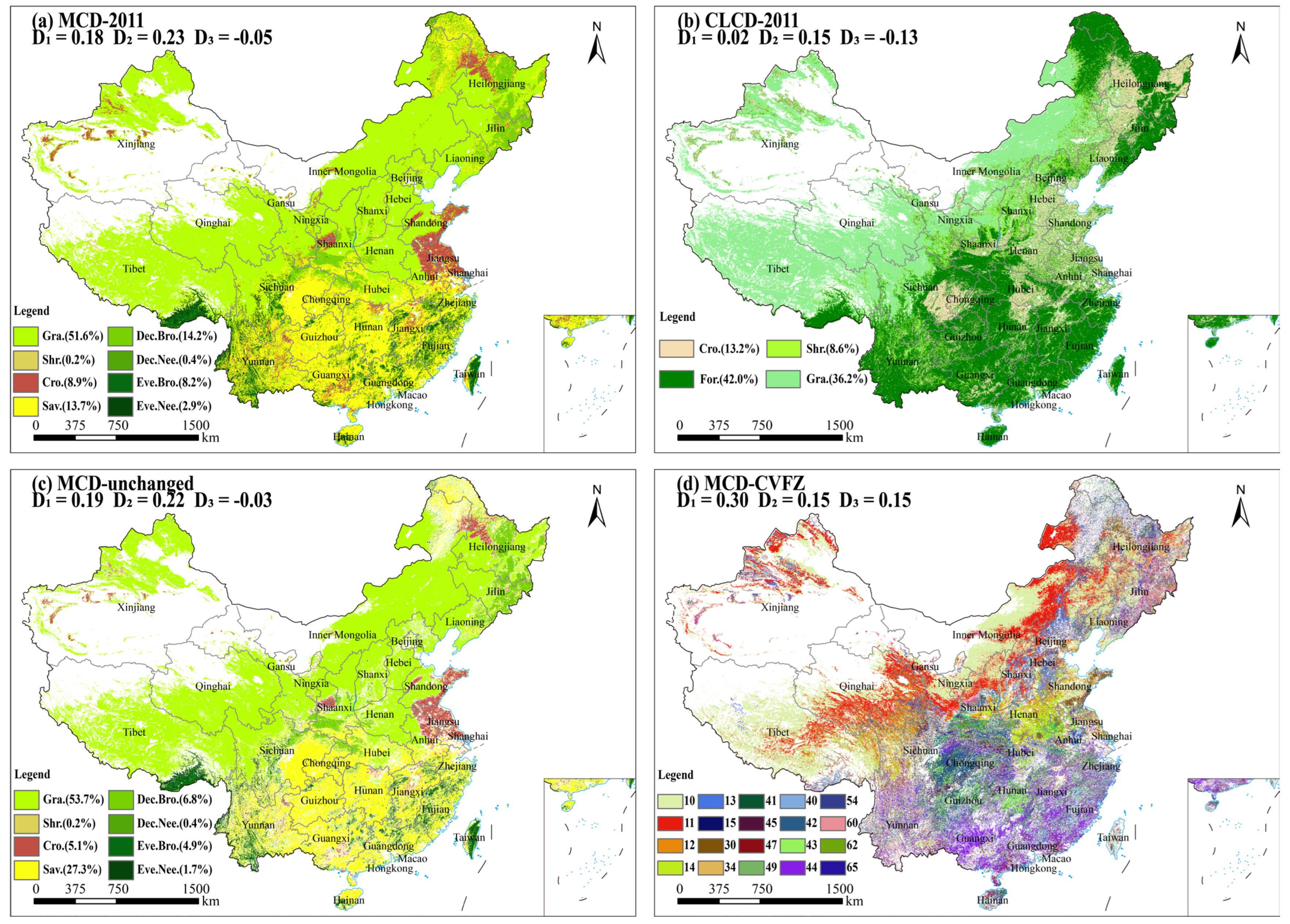
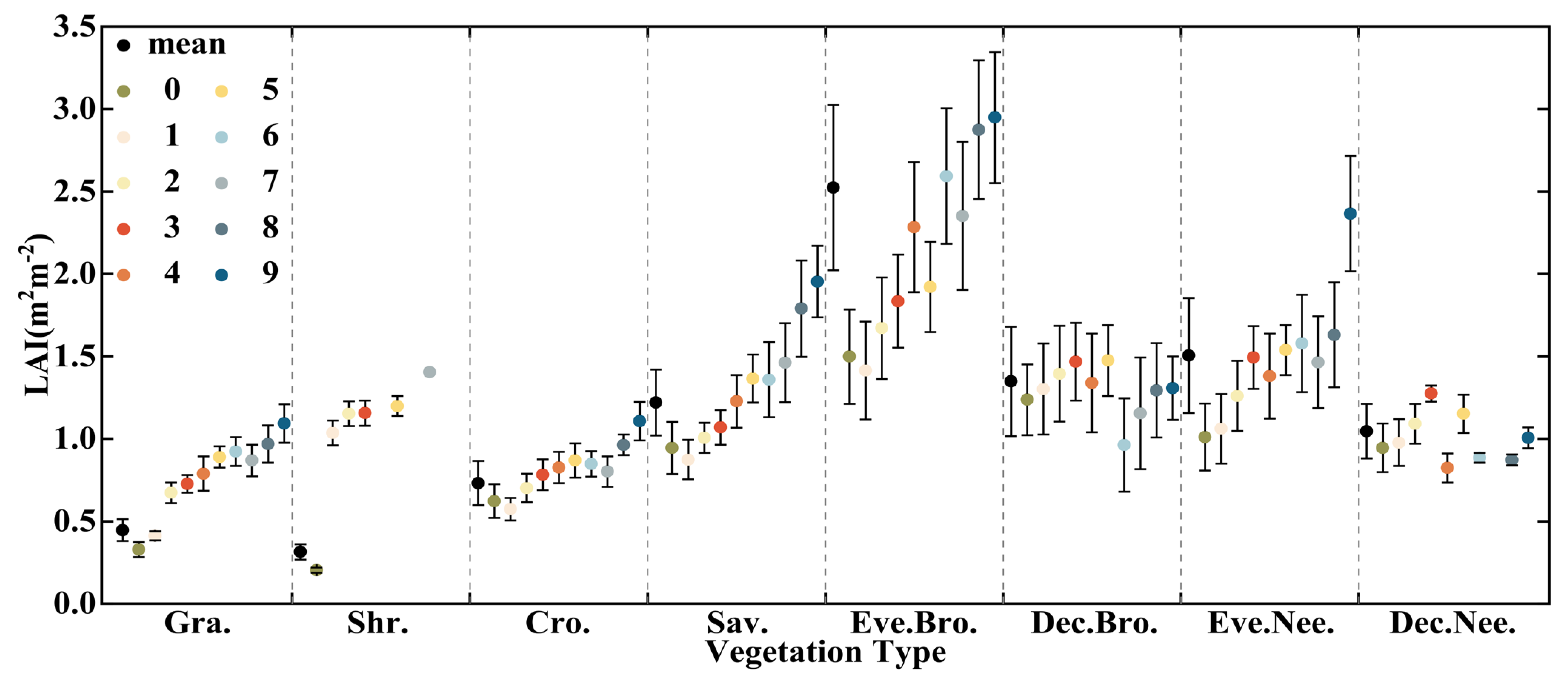
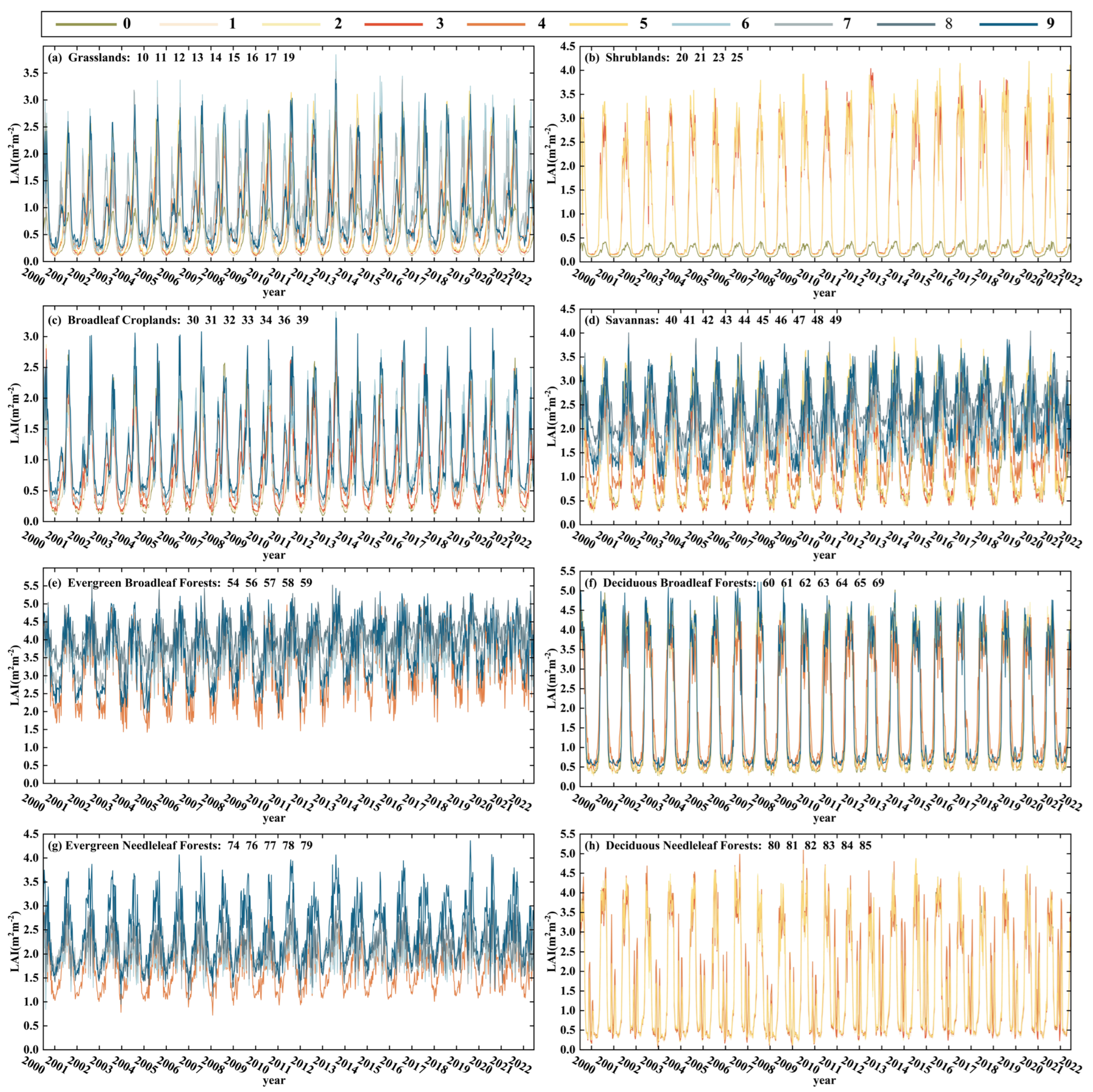
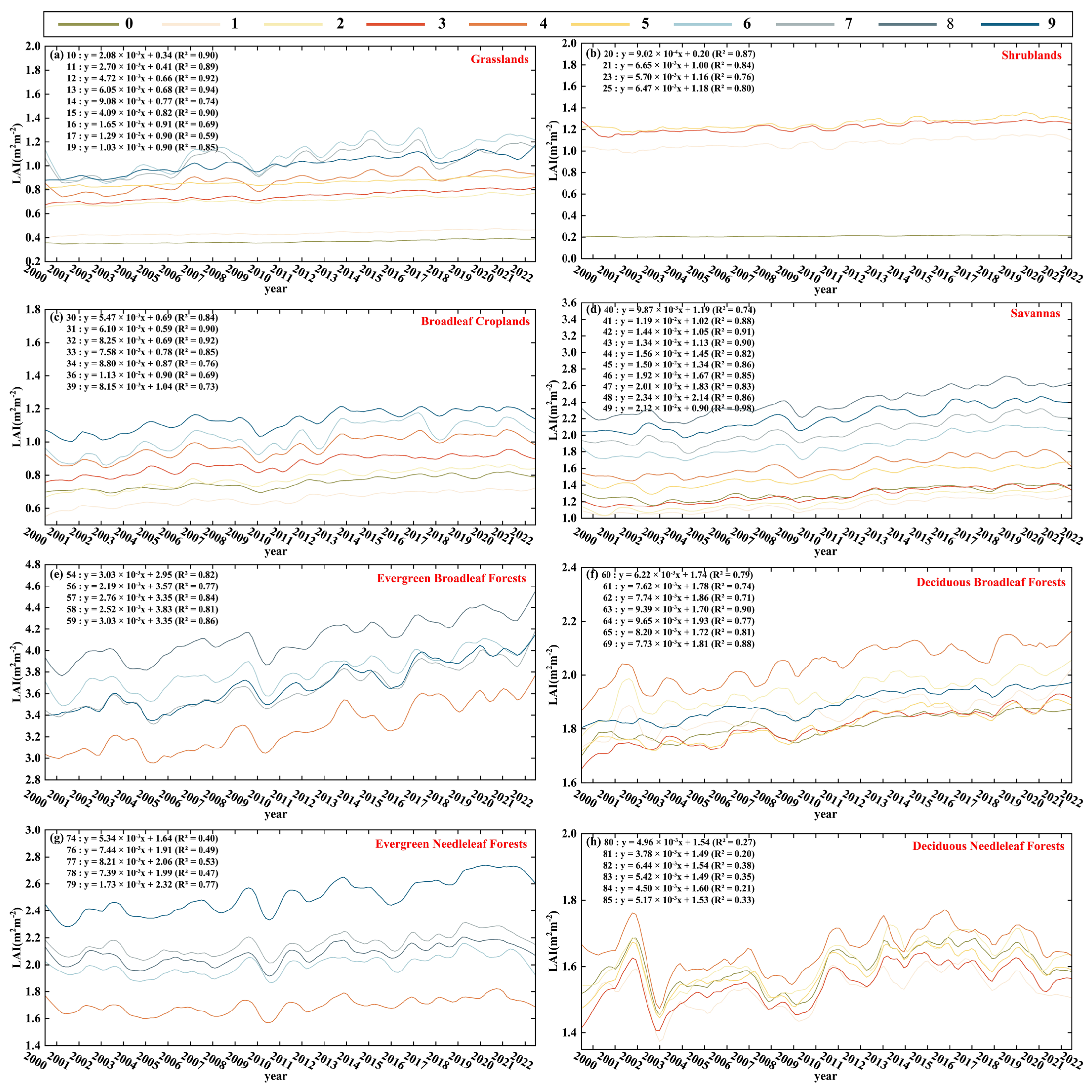
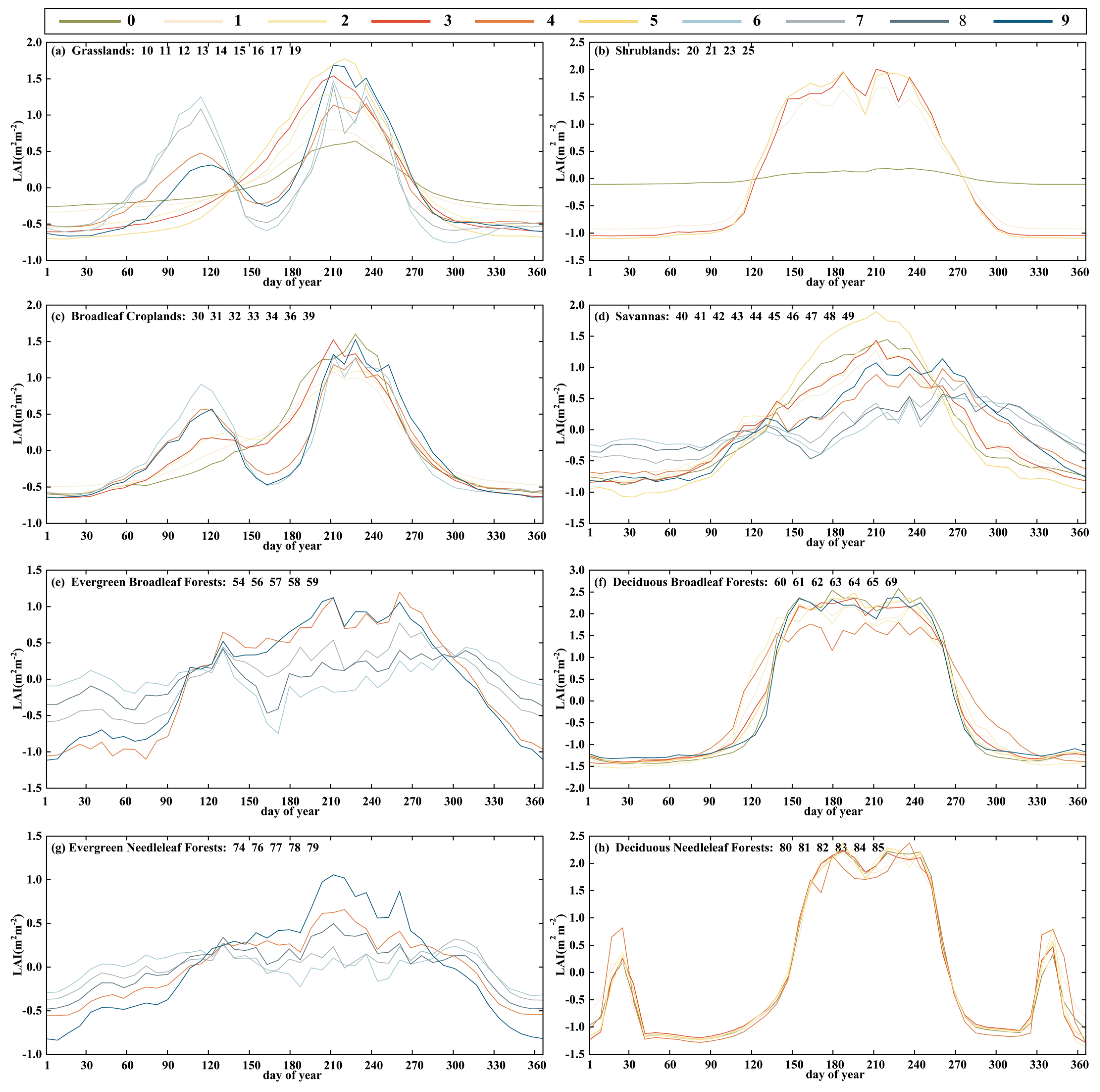


| Row | Column | Location | Vegetation Type | |
|---|---|---|---|---|
| 100.0% | 1689 | 1724 | Yunnan | Evergreen Needleleaf Forests |
| 3.9% | 1802 | 2707 | Taiwan | Savannas |
| 3.7% | 2090 | 2125 | Hainan | Savannas |
| 2.2% | 1828 | 2707 | Taiwan | Savannas |
| 1.8% | 1131 | 2117 | Shaanxi | Deciduous Broadleaf Forests |
| 1.6% | 1165 | 2070 | Gansu | Deciduous Broadleaf Forests |
| 1.5% | 752 | 2754 | Liaoning | Grasslands |
| 1.2% | 1288 | 2178 | Henan | Grasslands |
| 1.1% | 1738 | 2556 | Fujian | Evergreen Broadleaf Forests |
| 1.1% | 1063 | 2198 | Shanxi | Deciduous Broadleaf Forests |
| Threshold | 2.02 | 2.03 | 2.04 | 2.05 | 2.06 | 2.07 | 2.08 |
|---|---|---|---|---|---|---|---|
| MR | 0.0769 | 0.0633 | 0.0477 | 0.0318 | 0.0205 | 0.0134 | 0.0087 |
| D1 | 0.2581 | 0.2577 | 0.2571 | 0.2567 | 0.2562 | 0.2557 | 0.2553 |
| D2 | 0.2068 | 0.2063 | 0.2057 | 0.2051 | 0.2046 | 0.2042 | 0.2039 |
| D3 | 0.0513 | 0.0514 | 0.0514 | 0.0516 | 0.0515 | 0.0515 | 0.0514 |
Disclaimer/Publisher’s Note: The statements, opinions and data contained in all publications are solely those of the individual author(s) and contributor(s) and not of MDPI and/or the editor(s). MDPI and/or the editor(s) disclaim responsibility for any injury to people or property resulting from any ideas, methods, instructions or products referred to in the content. |
© 2023 by the authors. Licensee MDPI, Basel, Switzerland. This article is an open access article distributed under the terms and conditions of the Creative Commons Attribution (CC BY) license (https://creativecommons.org/licenses/by/4.0/).
Share and Cite
Xu, T.; Yan, K.; He, Y.; Gao, S.; Yang, K.; Wang, J.; Liu, J.; Liu, Z. Spatio-Temporal Variability Analysis of Vegetation Dynamics in China from 2000 to 2022 Based on Leaf Area Index: A Multi-Temporal Image Classification Perspective. Remote Sens. 2023, 15, 2975. https://doi.org/10.3390/rs15122975
Xu T, Yan K, He Y, Gao S, Yang K, Wang J, Liu J, Liu Z. Spatio-Temporal Variability Analysis of Vegetation Dynamics in China from 2000 to 2022 Based on Leaf Area Index: A Multi-Temporal Image Classification Perspective. Remote Sensing. 2023; 15(12):2975. https://doi.org/10.3390/rs15122975
Chicago/Turabian StyleXu, Tianchi, Kai Yan, Yuanpeng He, Si Gao, Kai Yang, Jingrui Wang, Jinxiu Liu, and Zhao Liu. 2023. "Spatio-Temporal Variability Analysis of Vegetation Dynamics in China from 2000 to 2022 Based on Leaf Area Index: A Multi-Temporal Image Classification Perspective" Remote Sensing 15, no. 12: 2975. https://doi.org/10.3390/rs15122975
APA StyleXu, T., Yan, K., He, Y., Gao, S., Yang, K., Wang, J., Liu, J., & Liu, Z. (2023). Spatio-Temporal Variability Analysis of Vegetation Dynamics in China from 2000 to 2022 Based on Leaf Area Index: A Multi-Temporal Image Classification Perspective. Remote Sensing, 15(12), 2975. https://doi.org/10.3390/rs15122975







